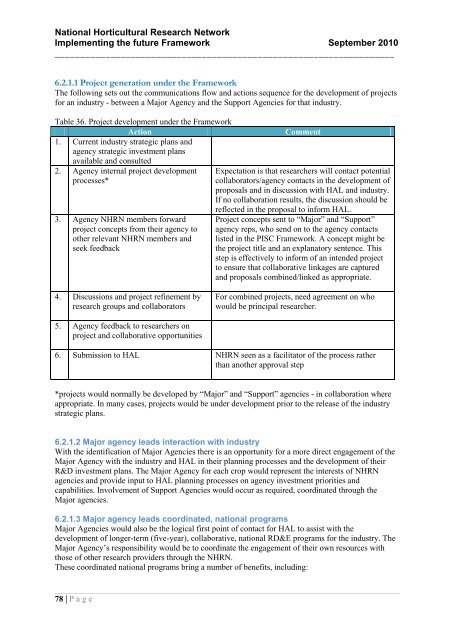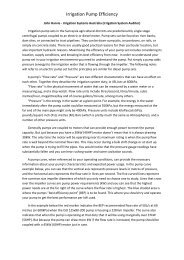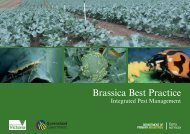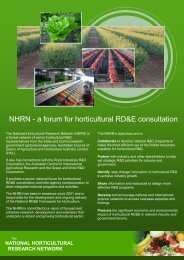National Horticultural Research Network - Horticulture Industry ...
National Horticultural Research Network - Horticulture Industry ...
National Horticultural Research Network - Horticulture Industry ...
You also want an ePaper? Increase the reach of your titles
YUMPU automatically turns print PDFs into web optimized ePapers that Google loves.
<strong>National</strong> <strong>Horticultural</strong> <strong>Research</strong> <strong>Network</strong><br />
Implementing the future Framework September 2010<br />
___________________________________________________________________<br />
6.2.1.1 Project generation under the Framework<br />
The following sets out the communications flow and actions sequence for the development of projects<br />
for an industry - between a Major Agency and the Support Agencies for that industry.<br />
Table 36. Project development under the Framework<br />
Action<br />
Comment<br />
1. Current industry strategic plans and<br />
agency strategic investment plans<br />
available and consulted<br />
2. Agency internal project development<br />
processes*<br />
Expectation is that researchers will contact potential<br />
collaborators/agency contacts in the development of<br />
proposals and in discussion with HAL and industry.<br />
If no collaboration results, the discussion should be<br />
3. Agency NHRN members forward<br />
project concepts from their agency to<br />
other relevant NHRN members and<br />
seek feedback<br />
reflected in the proposal to inform HAL.<br />
Project concepts sent to “Major” and “Support”<br />
agency reps, who send on to the agency contacts<br />
listed in the PISC Framework. A concept might be<br />
the project title and an explanatory sentence. This<br />
step is effectively to inform of an intended project<br />
to ensure that collaborative linkages are captured<br />
and proposals combined/linked as appropriate.<br />
4. Discussions and project refinement by<br />
research groups and collaborators<br />
For combined projects, need agreement on who<br />
would be principal researcher.<br />
5. Agency feedback to researchers on<br />
project and collaborative opportunities<br />
6. Submission to HAL NHRN seen as a facilitator of the process rather<br />
than another approval step<br />
*projects would normally be developed by “Major” and “Support” agencies - in collaboration where<br />
appropriate. In many cases, projects would be under development prior to the release of the industry<br />
strategic plans.<br />
6.2.1.2 Major agency leads interaction with industry<br />
With the identification of Major Agencies there is an opportunity for a more direct engagement of the<br />
Major Agency with the industry and HAL in their planning processes and the development of their<br />
R&D investment plans. The Major Agency for each crop would represent the interests of NHRN<br />
agencies and provide input to HAL planning processes on agency investment priorities and<br />
capabilities. Involvement of Support Agencies would occur as required, coordinated through the<br />
Major agencies.<br />
6.2.1.3 Major agency leads coordinated, national programs<br />
Major Agencies would also be the logical first point of contact for HAL to assist with the<br />
development of longer-term (five-year), collaborative, national RD&E programs for the industry. The<br />
Major Agency‟s responsibility would be to coordinate the engagement of their own resources with<br />
those of other research providers through the NHRN.<br />
These coordinated national programs bring a number of benefits, including:<br />
78 | P a g e






